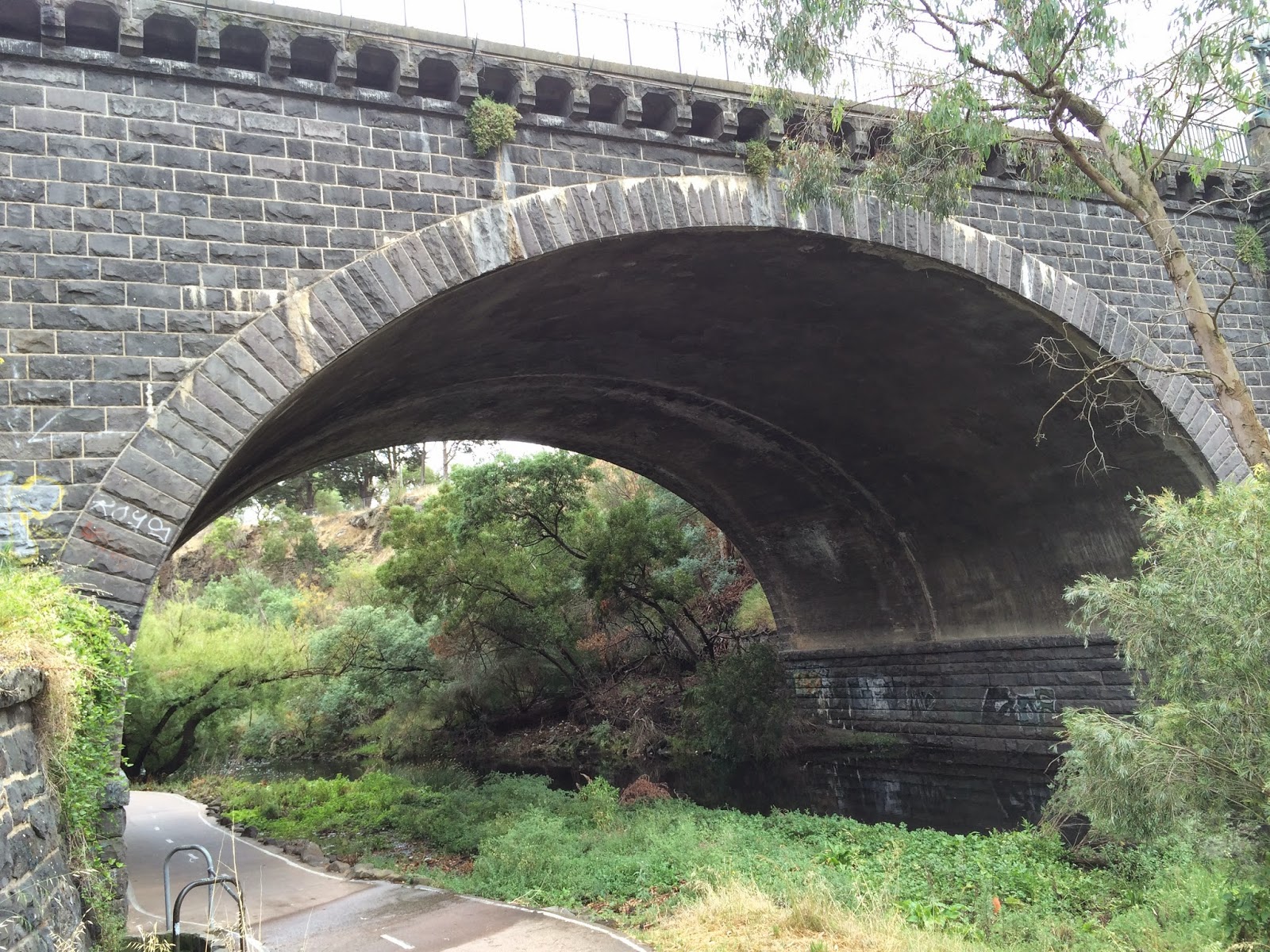The second of the two bluestone bridges on one of my regular walks along the Merri runs along Heidelberg Road. The bridge is one of the oldest stone bridges in Melbourne, according to the wonderful Encyclopedia of Melbourne, edited by Andrew Brown-May and Shurlee Swain, a book that is becoming a constant companion for this project. Ah, and I see it is also online and searchable: wonderful!!
The Heidelberg Rd bridge was built, according to a Darebin local history, between 1849 and 1852. But there is an article in The Argus of 11 June, 1868 that describes this "very substantial bluestone structure" replacing the old wooden bridge. Unlike the bridge I posted about yesterday, this is a single span bridge, made entirely of bluestone.
And here is an older photograph from road level:
I have also just now spend a funny hour googling this bridge and finding all sorts of websites and documents online: local histories and other sites that will make this year's bluestone project easier, though the pdfs are often quite hard to read, and I will of course also spend time -- or ask Helen, my wonderful research assistant on this project -- to spend time, in the libraries. Local histories tell me Heidelberg road was the first to be built leading out of the city of Melbourne; and that there was a flurry of activity mid-century after the colony of Victoria became financially independent of New South Wales.
The best affective moment comes from a report to the Victorian parliament of 1852 from the committee on Roads and Bridges, with transcripts of interviews with various officials. I've just scanned quickly, but this is my favourite exchange. Robert Hoddle, the city's surveyor, is called before the committee of December 4, 1851. (One of Melbourne's main thoroughfares is named after Hoddle; he laid out the city's distinctive grid plan in 1837.) His answer to question 116 is beautifully candid.
The Heidelberg Rd bridge was built, according to a Darebin local history, between 1849 and 1852. But there is an article in The Argus of 11 June, 1868 that describes this "very substantial bluestone structure" replacing the old wooden bridge. Unlike the bridge I posted about yesterday, this is a single span bridge, made entirely of bluestone.
And here is an older photograph from road level:
I need to do some work on my architectural vocabulary to describe the fanciness along the top of the bridge.
I have also just now spend a funny hour googling this bridge and finding all sorts of websites and documents online: local histories and other sites that will make this year's bluestone project easier, though the pdfs are often quite hard to read, and I will of course also spend time -- or ask Helen, my wonderful research assistant on this project -- to spend time, in the libraries. Local histories tell me Heidelberg road was the first to be built leading out of the city of Melbourne; and that there was a flurry of activity mid-century after the colony of Victoria became financially independent of New South Wales.
The best affective moment comes from a report to the Victorian parliament of 1852 from the committee on Roads and Bridges, with transcripts of interviews with various officials. I've just scanned quickly, but this is my favourite exchange. Robert Hoddle, the city's surveyor, is called before the committee of December 4, 1851. (One of Melbourne's main thoroughfares is named after Hoddle; he laid out the city's distinctive grid plan in 1837.) His answer to question 116 is beautifully candid.
114. Q. Have you employed any person you have faith in, to lay out the roads? A. I have faith in all the gentlemen I employ; but the laying out of roads is the most difficult part of a Surveyor's duty.There is something completely charming about this candour. Faith is crucial, but stupidity is damning, and even engineers and surveyors and builders bring an affective charge to their work.
115. Q. Is it not necessary that they should understand it? A. I invariably select the most intelligent for this work.
116. Q. As in the case of Kilmore? A. You could not have selected a more unfortunate example, for the Surveyor there showed himself a most stupid man.









2 comments:
I love to pause on the staircases inside Trades Hall (corner of Lygon and Victoria streets). Imagining the thousands of feet that have worn smooth hollows into the bluestone treads, the callused strong hands that have slid along the wooden railings. I've heard many great yarns about the characters and events seen in Trades Hall over many decades; it's when I ascend the stairs, walking slowly and with care so as not to slip on those silky stone surfaces, that the stories feel most real.
Isn't it odd that we can describe a stone surface as silky? I know exactly what you mean, too.
The internal stairs at Trades Hall are bluestone? Great. Thanks for the tip; and watch out for future posting!
And generally, yes there is something about the way stone holds narrative, I'm sure. I'll be trying to think this through a little more.
Thanks for the comment. Terrific!
Post a Comment